As an Amazon Associate I earn from qualifying purchases.
When you make a recipe with only a few ingredients, technique becomes more important. Such is the case with green chile stew.
Green chile stew is a New Mexico favorite, but you will see it all over the Desert Southwest, and there are versions of it across the border in Mexico, too.

Keep in mind, however, that this is not Mexican chile verde, which hinges on tomatillos and Mexican herbs and is, in general, made very differently, despite the dominance of green chiles.
Green chile stew is almost always made with either beef or pork; I used venison here. All of these meats are ideal, as would javelina, bison, elk, moose, lamb or mutton, or goat.
As you might imagine, variations exist with this recipe. Some use tomato; I do not. Some use either sweet or field corn; I do. Most, however, use potatoes, lots of roasted, peeled and seeded green chiles — Hatch (Anaheims) would be natural here — and all feature a touch of cumin, garlic and onions.
Some versions use no thickener. Some use a flour-and-fat roux. I use the old European technique of flouring the meat first, then browning. Over time, the flour in the pot that comes off the meat will thicken the green chile stew.
And thickness is your call, too. What I like to do is make the initial batch properly stewy, as you see in the pictures here. You eat it with a spoon and there is broth. Later, however, I will cook it down, and smash the potatoes and meat with a potato masher, and then it becomes more of a Mexican guisado, and in fact it is similar to my recipe for venison carne guisada.
Pro tip: Use this thickened, cooked-down green chile stew as a filling for empanadas, burritos or as a taco filling. Oh, and here you definitely want flour tortillas.
(I have a wonderful recipe for homemade flour tortillas here.)
About technique. You want to really take your time browning both the meat and the onions because it makes or breaks the stew. You will see renditions of green chile stew that are wan and pale. That tells you the cook was in a hurry, or he, for reasons known only to God, doesn’t like browned meat.
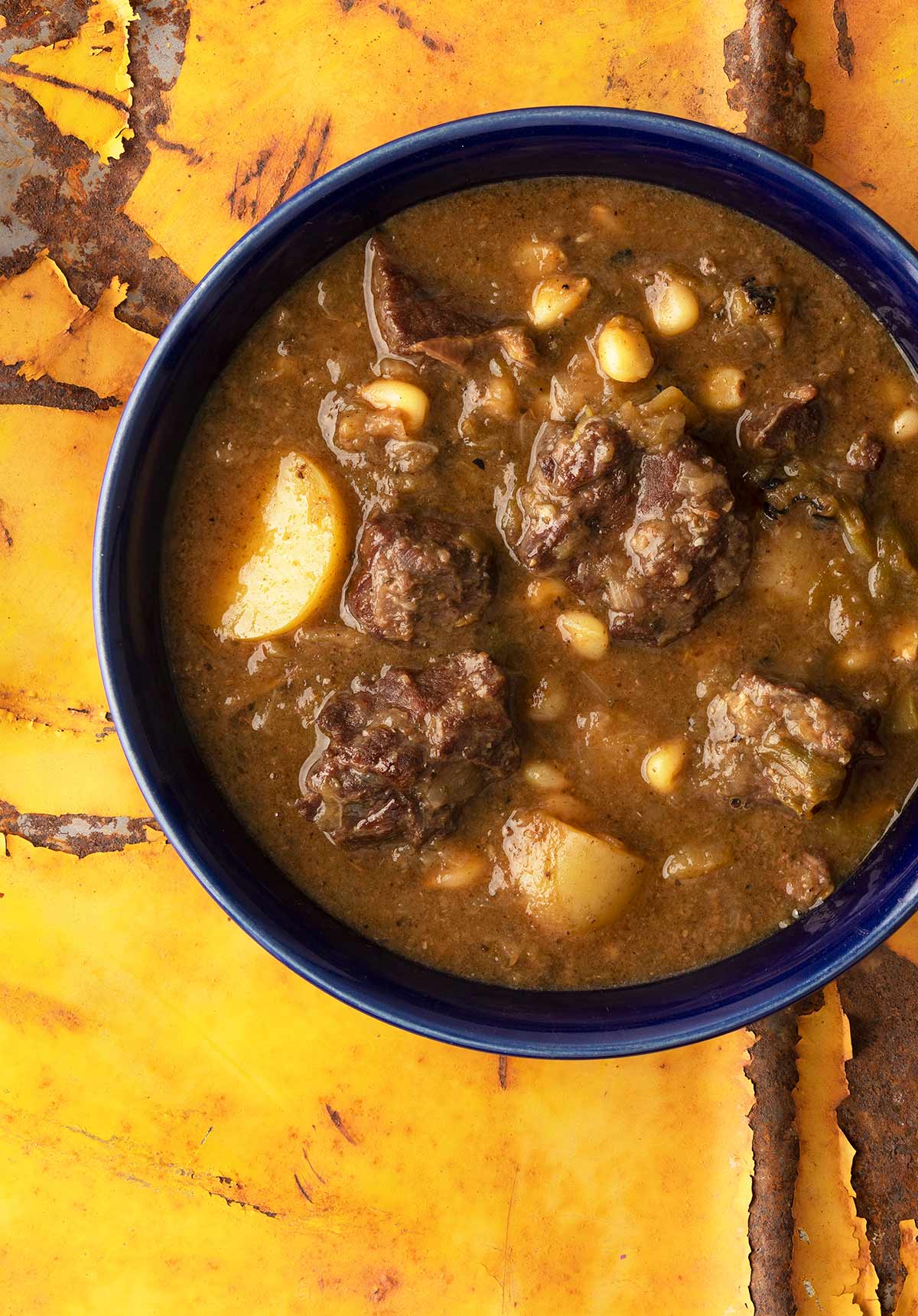
Also, you will want to determine how much you want to actually see the roasted green chiles. They will dissolve as they cook, so you will either have them as a ghostly presence in your green chile stew, or, if you put them in during the final 30 minutes, you’ll have them as a vegetable. Up to you. I do both. Mild chiles go in early, hot ones late.
(Here is a tutorial on how to roast green chiles, if you don’t already know how.)
Which chiles you use is also a judgment call. Ideally, you would use Hatch chiles from New Mexico. But Anaheims are the same basic variety. Poblanos are an excellent alternative, albeit more Mexican than New Mexican, but any large not overly hot green chile will work. And yes, in this case, you can use canned or dried. I really love using homemade chiles pasados, the dried, roasted chiles they make in Durango and Chihuahua.
Finally, corn or no corn? I really like using chicos, the dried corn that is common in the Southwest. It’s firm, even after long cooking, and starchy, not sweet. Use chicos if you can get them, otherwise simple fresh or frozen sweet corn is fine. Or leave it out.
Once made, your green chile stew will keep in the fridge a week. It can be pressure canned and frozen, too.
OTHER GREEN CHILE DISHES
Some of these are similar to green chile stew, some not so much, but all make good use of roasted green Hatch chiles, which I love.
- Green chile elk cheeseburgers. Obviously you can use whatever ground meat you have on hand.
- Green chile mac and cheese. This one’s more than a little epic, especially on a chilly night.
- Pork chile verde. This is a Mexican dish common throughout that country. Thicker than this soup, and with lots of tomatillos.
- Green chile chicken soup. This is a Southwestern-style soup with roasted green Hatch chiles, white beans, greens and a rich broth.
Green Chile Stew
Ingredients
- 1 cup dried field corn (chicos), (optional)
- 1/4 cup vegetable oil or lard, divided
- 2 to 3 pounds venison stew meat, or beef or pork
- Salt
- 1/2 cup flour
- 2 cups chopped white or yellow onions
- 4 cloves garlic, chopped
- 1 tablespoon cumin
- 1 tablespoon Mexican oregano (optional)
- 1 quart venison or beef broth
- 1 pound roasted, seeded green chiles, chopped
- 1 1/2 pounds Yukon gold potatoes, cut in chunks
- Black pepper and hot sauce to taste
Instructions
- If you are using the dried corn, put it in a pot of water and start boiling it before you start anything else, because it can take a long time to soften.
- Salt the venison well, then dust it in the flour, pressing the flour into the meat. Heat 2 tablespoons of the lard or vegetable oil in a Dutch oven or similar soup pot set over medium-high heat.
- When the oil is hot, brown the meat in batches. Make sure no piece is touching another, and take your time with this. You want each piece well browned. Move them to a bowl as you go. You will likely need to add another tablespoon of oil late in this process.
- When the meat is all browned, add the final tablespoon of oil and the onions. Stir this well, as the moisture from the onions will deglaze the pot. You want that. Sauté the onions until they too are nicely browned. This whole process, meat and onions, can take 30 minutes or more.
- Add the garlic to the pot, stir well and cook a minute or three. Return the meat and all of the accumulated juices in the bowl to the soup pot. Add the cumin, oregano and broth, then another quart or even two of water. Stir and bring to a simmer. Add salt to taste. If you are using the field corn, move it from the plain water to the soup pot now to continue cooking.
- If you want green chiles as an invisible presence in your stew, add them now. Or add some now and some later. Regardless, simmer the stew until the meat is mostly tender, anywhere from an hour for pork to three hours for an old deer or elk.
- When the meat is getting close, add the potatoes and chiles, if you haven't already. You can add sweet corn here, too, if that's the choice you made. Simmer gently until the potatoes are ready, then add salt and pepper and serve.
Video
Nutrition
Nutrition information is automatically calculated, so should only be used as an approximation.


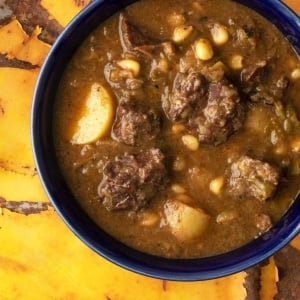
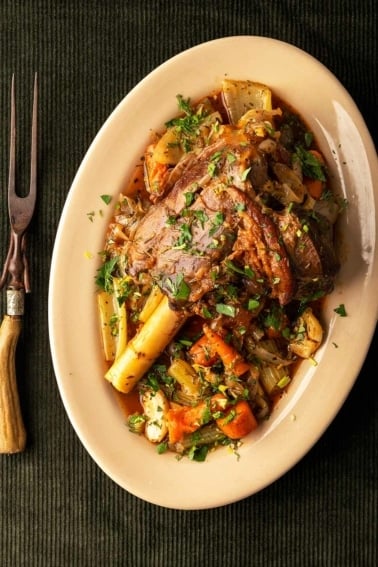
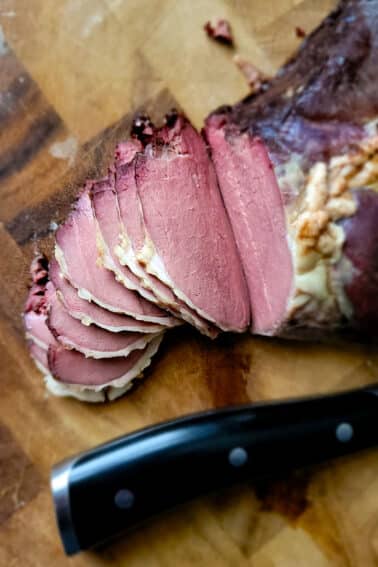

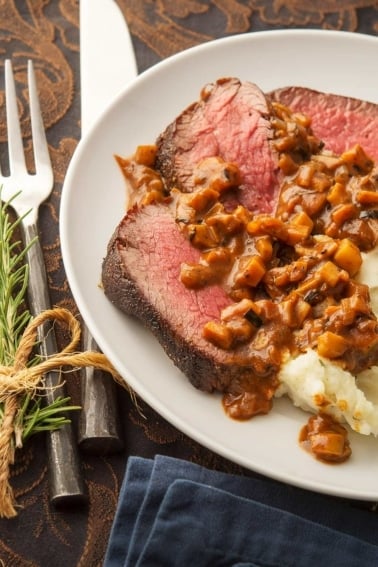
Planning on making this soon with Javelina – would you recommend breaking down the leg first (aka remove the muscles) or can we sear the whole thing and then remove the bones after cooking? If we go with whole – I think we’ll slow cook it for several hours ….
Jonathan: Either way would work. Cutting it into chunks will decrease cook time.
Thank you again for another keeper! We were amazed at the tenderness of the venison. Had my heart set on trying this recipe today, before I realized the I didn’t have any more Hatch in my freezer that I’d roasted when it was available here, and had to resort to a bag of diced frozen Hatch peppers that had not been seeded, or at least not seeded well. We didn’t notice the seeds. Used venison stock made with your recipe. We really enjoyed this recipe.
Very versatile recipe that lends itself to curiosity and substitution to preference. We prepared this with cubed black bear meat and a dark wild turkey stock and it was fantastic.
Thank you for sharing this!
I absolutely love this recipe and buy extra hatch chiles during our “hatch fest” in town just so I’ll have plenty. This stew ages very nicely and leftovers are even better so make plenty.
Hi Hank, this recipe sounds delicious as is every recipe of yours I have tried. I love NM green chili in all its variants. I am also in love with Rudy’s Texas BBQ green chili stew, and I wonder if anyone know how similar their stew is to yours? They use both potatoes and tomato, no corn, and I think put their leftover bbq beef in it. Has anyone tried both to do a compare and contrast?
I made this yesterday. It took most of the afternoon but it was worth it. I used meat off of a doe and a young buck I had harvested. I cannot get Hatch chilies so I used Anaheim and put 3/4 in early and saved 2 for putting in at the end of the cycle. It turned out very well except next time I may throw in a few Jalapenos or Serranos for a little more heat.
I can’t wait to try this!
I haven’t tried this recipe, Hank, but I’ve made plenty of AZ Green Beef Chile. I’ve had plenty of GCS in NM, & I recognize a competent version using good techniques. Historically, it makes sense that locals would use venison when available to replace mutton/lamb or goat (pre- the substitution of pork to placate weak-kneed diners, ha-ha!) I haven’t seen a tofu version yet, but I reckon one’s out there! Thanks – I’ll make some w/ available bison or lamb, maybe even chivo, w/ cumin freshly toasted whole & then ground + MX oregano, lots of black pepper (AZ-Sonora-style).
Made this stew tonight, this recipe is a keeper, I will be making it often during the fall and winter. Older tough elk meat was used, it turned melt in your mouth delicious. I try buy my spices at a local health food store which sells spices in bulk. The store goes through a lot of these bulk spices, which means the spices are so much fresher than the ones in the grocery store spices – I think this makes a big difference in the taste of the food.
I have several of Hank’s book refer to them often. Thanks Hank for your amazing recipes.
Your recipe is pretty much how I make it. I always add potatoes although I’m not sure which New Mexican family member I learned that from, or whether it just struck me as simpatico. No tomatoes. It’s an interesting thing about people’s preferences for cumin. I toast and grind my own cumin seed and find that the flavor is a lot different (better) than the commercial powder I find on the spice shelf at the grocery. I wonder if that is why people like it or don’t like it?
Easy but delicious stew on these subzero days. I shared with co-workers who all raved about it. This will become a staple in my home.
You say you can pressure can this. At what pressure and for how long? In quarts I’m assuming. Can wait to make this with the snow predicted fir the end of the week.
Cathy: It’s a pretty standard beef stew protocol, so where I live at 250 feet, it’s 10 PSI for 90 minutes. But follow the directions for your pressure canner.
HI Hank, I love your receipes and have you Buck, Buck, Moose cookbook. I’m going to make this recipe but I have a question on removing the skin on Poblano chilis. I’ve been doing green chilis for a long time but don’t seem to have the knack on poblanos…your thoughts would be appreciated.
Jim: You can use whatever green chile you are comfortable with. As for poblanos, I char the skins on a gas burner or over an open fire, then put them in a plastic bag to steam until they are no longer hot, about 30 minutes. Then I use a butter knife to scrape the skins off.
Hank, another great comfort food recipe. Quick question. If using canned chiles is it a one-for-one weight substitution (i.e., I’d need 16 oz of canned chiles)?
Ed: Yes, I would. You really can’t have too much green chile in this, so long as you are not using only hot ones.
Not all use potatoes. I’ve never used potatoes in mine or corn. From pueblo colorado
Lori: So I am seeing! Pretty much every recipe I’d checked, and there were a lot of them, had potatoes, but you are right. Several commenters have set me straight.
Hi Hank,
Fantastic recipe, its very similar to my family recipe (our Garcia clan has been there for 400 years). We almost always use potatoes and chicos (if we can find them, I live in california too). But to each their own, potato or no potato, it is still the food of the gods. thanks for sharing.
Tasty Tasty Hank. Thanks. I usually jump to recipe,but with Hank,i read the interesting story.You are the Elvis of exotic food, re della . salsiccia.Bravissimo!!!!!!!!!!!!!!!!!from your ammiratore from Vancouver island.
I live on the northwest side of New Mexico. Mutton, pork and venison(elk) is used. Pozole fresh, canned or dried (yellow canned works for me). We include a (10 ounce) can diced tomatoes (rotel or store brand). I also add 1/2 of the onion and 1/2 roasted chopped chilies during the last 1/2 hr of cooking. If we don’t have broth we add 2 – 4 pigs feet or a couple of pounds of leg bones, remove before serving. The collagen from the feet/bone gives flavor and body to the stew. One bay leaf for a short time during cooking then removed. Most don’t use any cumin, as it is to strong and takes over all other flavors. Green chilies can be very mild to very hot, i use medium and have a bowl of diced hot for guests to add on the side.
Hi Hank, thanks for reminding me of making green chile stew. I grow my own grass-fed, organic beef, pork and green chiles and for some reason, I haven’t made this stew for a couple years. I used to live in Taos, NM for decades…just moved to CA a few years ago. I even have chicos dried in Taos Pueblo! There are many versions of green chile stew. Some are with juniper berries, others with tomatoes, most without potatoes. We cook pinto beans separately and serve the beans and chile side by side, but eaten together. Cumin is not a regular ingredients, but accepted. Oregano is more common. I like cumin in my green chile stew but when I brought my stew with beans and cumin to a potluck, a local asked who made the beans. I had no idea it was not considered green chile…lol. She corrected me and said never use cumin or rosemary, both of which I had added….nor the beans! sigh. I’m off to make this stew today with cheek meat and oxtail from my steer that I slaughtered last fall! I’m going to add diced tomatoes, juniper, and no cumin. I love your blog and have kept several recipes of yours. Thank you!
Good stuff! I like to leave out the potatoes and then add mashed potatoes to the bowl.
This is a really solid green chile stew recipe. My Fall outings always include picking up (at least) a half dozen quarts of roasted green chiles out on Colorado’s Western Slope for cooking over the Winter. I tend to lean towards a small amount of small dice roasted tomato in mine instead of corn, and always use Masa when browning the meat. I made this with rabbit and wild turkey, (different batches) and it was marvelous.
Always excited when I see a new recipe come across my email feed from Shaw. As a transplanted New Mexican now in CO I still love my green chili and have a bushel picked up every harvest so I can use thru out the year. This recipe is pretty darn close to the staple I use. One simple trick is to pulverize in a blender 1/3 to 1/2 of the chili in the beginning which helps infuse more of that flavor into the stew while cooking. Add the rest towards the end so you get the “meaty” texture of the chili too. Best of both worlds.